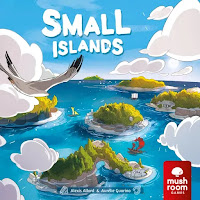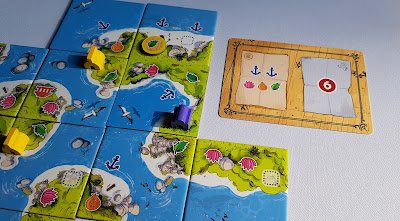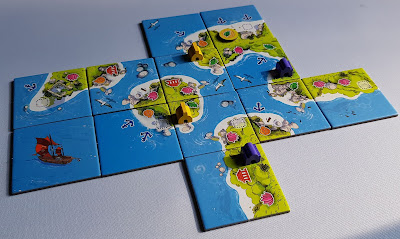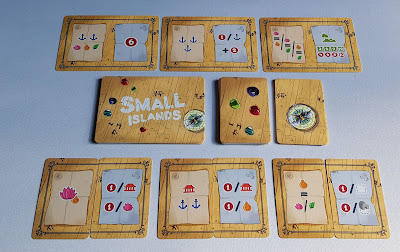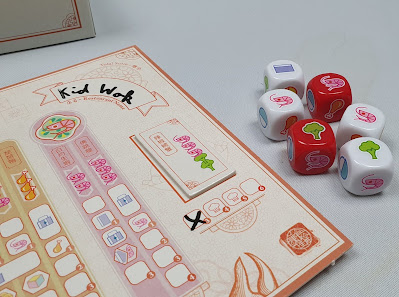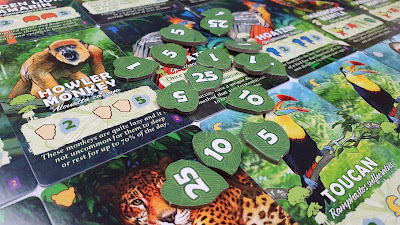Game:�Small IslandsPublisher:�MushrooM Games & Lucky Duck GamesDesigner:��Alexis AllardYear:�2018The first impression of Small Islands is like a maritime Carcassonne - it has the familiar square tiles, with land and sea edges that must be matched as you build a central...
Game:�Small Islands
Publisher:�MushrooM Games & Lucky Duck Games
Designer:��Alexis Allard
Designer:��Alexis Allard
Year:�2018
The first impression of Small Islands is like a maritime Carcassonne - it has the familiar square tiles, with land and sea edges that must be matched as you build a central landscape together throughout the game. Like many gamers, Carcassonne was one of our first modern board games and it's one that has really stood the test of time, with a number of expansions having also been crammed into our base game box over the years.
�Small Islands caught our eye when it was shown at the UK Games Expo a few years ago and then I had regrets when it was really hard to find for the next couple of years. Thankfully, that problem has been solved, with Lucky Duck Games announcing a reprint of Small Islands to share it with a larger audience and we have been excited to give it a try.
�
Gameplay
�
At the start of a game of Small Islands four island tiles are arranged in the center of the table to form the start of the play area. Each player then gets two random island tiles each and an objective card. Each round of the game a market of three tiles will be made available with a stack of tiles depending on player count to be used to refill the market. Players will get to draw two more objective cards, choosing from their three; one to score this round, one to save for next round and one to discard. The round will then begin with players taking it in turns to draw a tile from the market and then place a tile into the play area. This continues until the stack of market tiles for the round has been depleted at which point any player may choose to place a boat instead of an island tile in order to end the round.�
�
The island tiles themselves are rather simple with only two terrain features: land and water. Land must always connect to land and water must always connect to water, essentially if the tiles look nice then you are playing by the rules. On the islands you'll find several features; Three different types of fruit, temples, anchors, and construction sites. These are all involved with the objectives you chose, which are the only ways to gain points. Objectives will typically ask for an island with more of one fruit type than another, or with a minimum combination of one temples and two anchors or similar. Should an island meet these criteria then once the round ends you will be able to place one of your buildings on a construction site on the island and then score the scoring half of the objective card.�
�
�
Amy's Final Thoughts
�
Small Islands certainly sticks to the Carcassonne school of making a map out of tiles. But while there are many similarities Small Islands manages to be both simpler and more complex. The tile laying itself is incredibly simple, with only two types of terrain on the board you'll usually be spoilt for choice on where to place your tile for the round. However with three tiles in your hand to choose from and a wealth of scoring options available, trying to work out where is best to play can be a minefield. Each island can only be scored by each player once, so do you make a small island with only one building spot on it, in the hope that you get there first? If a sprawling island appears that meets your objectives for the round do you build on it, or wait for it to grow more next round? If you wait you always run the risk of it being merged with another island that you've already scored, and then you can't build there again since you have a hut on the, now humongous, island.�Amy's Final Thoughts
�
�
Not only are you thinking about our current scoring objective, but you also saved one for next round, it's perfectly viable to tank your scoring in round one to prepare for a better score in round two. Though since everyone is working together to make the islands it's rare you get complete control over how a landmass develops. The objectives themselves have an impressive amount of variability for cards that are all about the combinations of the game's six symbols. Unfortunately this actually makes the game a little harder to pick up as some of the symbology on the objective cards can be a touch confusing. Keep the manual on hand so you can refer to it when the weirder cards appear.�
�
Fi�s Final Thoughts
�
Small Islands is a pretty interactive puzzle. Some rounds you'll be happily working away building out two or three islands that suit your scoring objective, whilst in other rounds you'll get stuck in a tug of war with another player - you have no idea exactly what objective they're trying to optimise, but whatever it is, it's undermining your objective at the same time. With two players this negative interaction is thankfully quite infrequent, but with or without it, there is certainly an interactive element to the game, since all islands are common and, so long as there is enough space, all players can score from every island. You want to try and avoid making an island that's more lucrative for an opponent than it is for yourself!
On the other hand, you could choose to be more laid back, not scoring too many islands early in the game, waiting for them to get larger and worth bigger points, or waiting for an objective card that is better suited to the opportunities available. Your choice of objective card really is the most critical one each round and the points scored can vary hugely from achieving just two or three points in a round to 20 or more from a great combination of islands.�
Although attractive and certainly not without merit, Small Islands was unfortunately just a little bit boring for me. Once you've selected a scoring card for the round, you choices become quite obvious and you're just making the best of the layout of the board and tiles available. Don't get me wrong, there are choices and you need to figure out the ones that will score most highly, I just don't find them to be interesting choices. Perhaps the game is just too simple for my taste, but there are other, perhaps more elegant tile-laying games, with simpler rules that I enjoy more.
�
You Might Like...
The artwork for both the cover and the game on the table is really bright and eye-catching. It's very visually appealing.Other than understanding symbology on the objectives cards, Small Islands is a very accessible game, with each round being a bitesize chunk.The advanced mode gives you more options to customise and optimise your strategyYou Might Not Like...
The wooden pieces are rather small and fiddly.Once you understand the game there is not significant hidden depth and we are concerned that we'll tire fast of the game.
The Verdict
6/10 Small Islands looks charming and it plays really smoothly, but ultimately, there's just not enough going on to give the game longevity in our collection. The choices feel quite obvious and, even though the game can look quite different each time you play, it feels exactly the same. Small Islands is a good game, but I'd rather play Carcassonne, which, even though it too is light, I believe it has far more interesting choices for you to make.
Small Islands�was a review copy kindly provided to us by�Lucky Duck Games.



